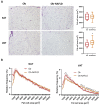A Distinctive NAFLD Signature in Adipose Tissue from Women with Severe Obesity
- PMID: 34638880
- PMCID: PMC8509058
- DOI: 10.3390/ijms221910541
A Distinctive NAFLD Signature in Adipose Tissue from Women with Severe Obesity
Abstract
Development and severity of nonalcoholic fatty liver disease (NAFLD) have been linked to obesity and white adipose tissue (WAT) dysfunction plays a key role in this relation. We compared the main features of subcutaneous (SAT) and visceral WAT (VAT) tissue dysfunction in 48 obese women without (Ob) and with NAFLD (Ob-NAFLD) undergoing bariatric surgery and matched for age, BMI and T2D status. Fat cell area, adipocyte size distribution, the degree of histological fibrosis and the mRNA expression of adipokines and genes implicated in inflammation, adipogenesis, angiogenesis, metabolism and extracellular matrix remodeling were measured by RT-qPCR in both fat depots. Ob-NAFLD group showed higher TG and lower HDL circulating levels, increased VAT fat cell area and similar WAT fibrosis in comparison with Ob group. A sPLS-DA was performed in order to identify the set of genes that better characterize the presence of NAFLD. Finally, we build a multinomial logistic model including seven genes that explained 100% of the variance in NAFLD and correctly predicted 100% of cases. Our data support the existence of distinctive NAFLD signatures in WAT from women with severe obesity. A better understanding of these pathways may help in future strategies for the prevention and treatment of NAFLD.
Keywords: NAFLD; adipose tissue; obesity.
Conflict of interest statement
The authors declare no conflict of interest.
Figures


References
Publication types
MeSH terms
Substances
Grants and funding
LinkOut - more resources
Full Text Sources
Medical
Research Materials
Miscellaneous

